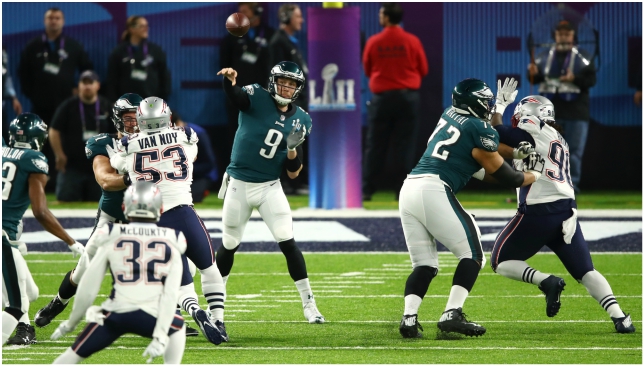
Super Bowl LII delivered a classic, back-and-forth battle for the biggest shootout in the game’s history.
Ultimately, the Philadelphia Eagles made enough plays to edge the New England Patriots 41-33 for the franchise’s first Super Bowl victory, ending the reign of the defending champions who were seeking their third title in four years and a sixth championship overall.
Eagles quarterback Nick Foles earned MVP honours as he threw for 373 yards and three touchdowns, while also pulling in a receiving score to become the first player ever to both throw and catch a touchdown in Super Bowl history.
Here’s a breakdown of the game and how it was decided:
Defence at a premium
So much for the adage ‘defence wins championships’. Super Bowl LII was ruled by offence as the attacks of both teams were unstoppable for nearly the entire 60 minutes.
Check out the records that were set: Most combined total yardage in any regular season or playoff game with 1,151; most passing yards in a postseason contest by a single player with Tom Brady’s 505; most combined passing yards in a Super Bowl with 874, and most points scored by a losing team in a Super Bowl with New England’s 33. The 74 combined points were one shy of tying the record for total points, set in Super Bowl XXIX.
If there’s one person who can’t be blamed for the Patriots’ loss, it’s Brady. The Patriots quarterback couldn’t have been expected to perform any better as he threw for the aforementioned 505 yards at a clip of 10.5 per attempt, and three touchdowns. Facing a 10-point hole coming out of halftime, Brady and the offence responded with touchdown drives on their first three possessions of the second half.
When Brady truly got into a rhythm, he was picking apart the Eagles’ man coverage with ease. Danny Amendola, Chris Hogan and Rob Gronkowski all topped 100 yards receiving, much of which came on chunk plays with Brady taking advantage of double moves to beat Philadelphia’s aggressive secondary downfield. New England never had to punt.
Got 'em, @dannyamendola! #SBLII #NotDone pic.twitter.com/CDCTsUKNfL
— NFL (@NFL) February 5, 2018
On the other side of the ball, Eagles head coach Doug Pederson did a masterful job of play-calling to keep the Patriots’ defence guessing.
When Philadelphia’s offensive line often had a numbers advantage against New England’s front, the ground game had large holes to run through and finished with 164 yards on 6.07 yards per rush.
The air attack, meanwhile, didn’t feature as many RPOs (run-pass options) as expected, with the Eagles instead having plenty of success out of their mesh/wheel concept, which features shallow crossing routes and the running back angling out of the backfield and down the sidelines. Some of the game’s most important plays came out of this concept, including Corey Clement’s 55-yard gain on a wheel route in the second quarter and tight end Zach Ertz’s drive-extending grab on a shallow cross to convert the fourth-and-1 in the fourth quarter.
Before postseason, Pederson went back and watched old Foles film to try to help the QB. Since, mesh/wheel, a staple under Chip Kelly has been a go-to play. Hit on it for the 55-yarder to Clement. Drawing here from the great @Coach_Flinn. Why coaching matters. pic.twitter.com/gznOKQ0g26
— Sheil Kapadia (@SheilKapadia) February 5, 2018
.@CoreyClement_6 gains 55 yards and puts the @Eagles in the red zone! #SBLII pic.twitter.com/NSkX9hJrD1
— NFL (@NFL) February 5, 2018
Foles also attempted 21 play-action passes – the most ever in Super Bowl history – and was 12-of-21 for 118 yards and a touchdown on them, according to ESPN Stats & Info.
Both offences were dealing, but the difference was one got a little more help from its defence as Brandon Graham’s strip-sack of Brady in the final minutes provided the key stop.
Patriots’ uncharacteristic mistakes
New England are known for excelling at situational football, but they looked unlike themselves in several crucial moments.
The red zone, along with third and fourth downs, are where games are won and lost. For as poorly as the Patriots’ defence played, they did well to hold the Eagles to two touchdowns on four red zone trips. The real problem, however, was getting off the field on third and fourth downs, which Philadelphia converted 10-of-16 times and on both occasions, respectively.
A number of those third down pick-ups came with New England defenders missing tackles and failing to bring down the ball-carrier before the line to gain.
Malcolm Butler could have likely helped, but the cornerback didn’t play any defensive snaps as he was bizarrely kept sidelined for an undisclosed reason.
In his place, Eric Rowe got the call and struggled for much of the first half against Alshon Jeffery before Stephon Gilmore drew the assignment in the second half and had more success.
Eric Rowe said he didn't know he was starting until right before game. Seemed as puzzled as rest of NE as to why no Malcolm Butler
— Tom E. Curran (@tomecurran) February 5, 2018
What a throw.
— NFL (@NFL) February 5, 2018
WHAT A CATCH.
This is just beautiful. @NFoles_9 + @TheWorldof_AJ. #FlyEaglesFly #SBLII pic.twitter.com/4EfKczLGQj
The Patriots didn’t fare much better in special teams – where they almost always have an edge – with Stephen Gostkowski missing a 26-yard field goal after a mishandled snap and then shanking an extra point.
Other miscellaneous errors included Brady’s scramble to lose time at the end of the first half and Bill Belichick’s decision to kick a field goal on fourth-and-1 from the 8-yard line, which resulted in Gostkowski’s miss.